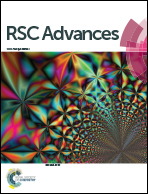Effect of post-heat treatment on the photocatalytic activity of titanium dioxide nanowire membranes deposited on a Ti substrate
Abstract
Titanium dioxide nanowire membranes have been synthesized by a hydrothermal growth on the surfaces of Ti substrates in a 12 M NaOH aqueous solution at 160 °C for 24 h, followed by ion-exchange with 0.5 M HCl aqueous solution and subsequent heat treatment such as calcination or a second hydrothermal treatment. The as-prepared TiO2 nanowires as well as their precursor were characterized by field emission scanning electron microscopy (FE-SEM), thermogravimetry-differential thermal analysis (TG-DTA), X-ray diffraction (XRD), the Brunauer–Emmett–Teller (BET) method, ultraviolet-visible (UV-Vis) spectrophotometry, transmission electron microscopy (TEM) and energy dispersive X-ray (EDX) spectrometry. FE-SEM observations indicated that the TiO2 nanowires were 50–250 nm in diameter and up to several dozens of microns in length. TG-DTA and XRD results demonstrated that the crystalline phases of the nanowires obtained from calcinations of their precursor at different temperatures above 350 °C consisted mostly of anatase. BET, UV-Vis, TEM and EDX results showed that the nanowires obtained upon calcination of their precursor at 550 °C had the greatest degradation efficiency for Rhodamine-B, and that, at the same temperature of 250 °C, the hydrothermal treatment process of TiO2-precursor nanowires had a more significant effect on the photocatalytic activity of the resulting TiO2 nanowires than the calcination.



 Please wait while we load your content...
Please wait while we load your content...